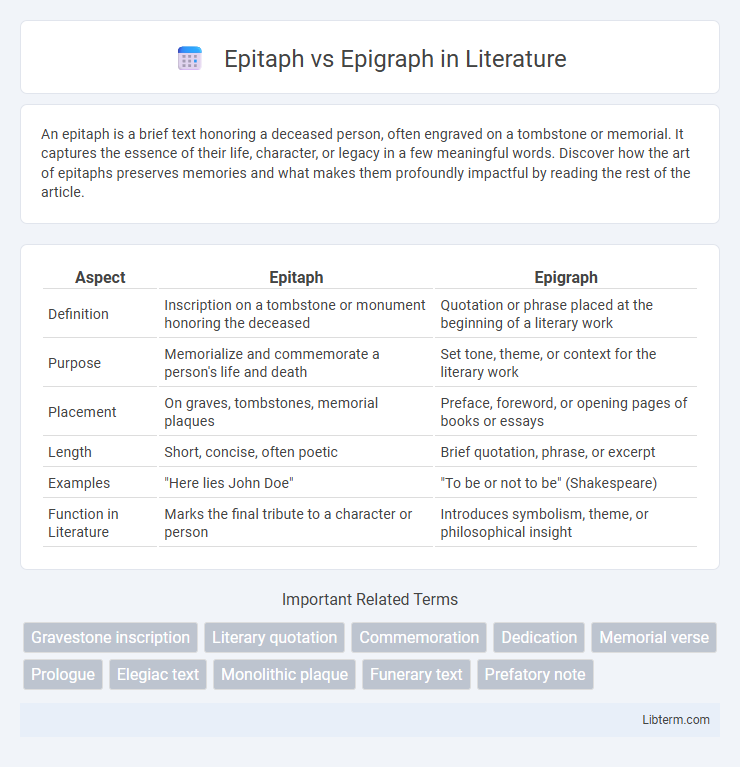An epitaph is a brief text honoring a deceased person, often engraved on a tombstone or memorial. It captures the essence of their life, character, or legacy in a few meaningful words. Discover how the art of epitaphs preserves memories and what makes them profoundly impactful by reading the rest of the article.
Table of Comparison
| Aspect | Epitaph | Epigraph |
|---|---|---|
| Definition | Inscription on a tombstone or monument honoring the deceased | Quotation or phrase placed at the beginning of a literary work |
| Purpose | Memorialize and commemorate a person's life and death | Set tone, theme, or context for the literary work |
| Placement | On graves, tombstones, memorial plaques | Preface, foreword, or opening pages of books or essays |
| Length | Short, concise, often poetic | Brief quotation, phrase, or excerpt |
| Examples | "Here lies John Doe" | "To be or not to be" (Shakespeare) |
| Function in Literature | Marks the final tribute to a character or person | Introduces symbolism, theme, or philosophical insight |
Understanding Epitaphs and Epigraphs
Epitaphs are brief inscriptions on tombstones or memorials that honor and summarize the life or death of a deceased person, often conveying personal sentiments or virtues. Epigraphs, on the other hand, are short quotations or phrases placed at the beginning of literary works, chapters, or essays to provide thematic context or insight. Understanding the distinct purposes of epitaphs and epigraphs enhances literary analysis and appreciation of commemorative traditions.
Etymology and Origins
Epitaph derives from the Greek words "epi," meaning "upon," and "taphos," which means "tomb," referring to inscriptions on gravestones honoring the deceased. Epigraph originates from the Greek "epi" and "graphein," meaning "to write upon," and denotes inscriptions or quotations placed at the beginning of literary works or chapters. Both terms share the Greek root "epi," highlighting their function as written texts displayed on or about surfaces, but differ in context: epitaphs are funerary inscriptions while epigraphs serve literary or commemorative purposes.
Definition of Epitaph
An epitaph is a brief text honoring a deceased person, typically inscribed on a tombstone or monument to commemorate their life and legacy. It often includes the individual's name, dates of birth and death, and a meaningful message or tribute reflecting their character or achievements. Unlike an epigraph, which is a quotation or phrase placed at the beginning of a literary work, an epitaph serves as a memorial inscription specifically related to death and remembrance.
Definition of Epigraph
An epigraph is a phrase, quotation, or poem set at the beginning of a document or a section of a text, designed to suggest its theme or provide context. Unlike an epitaph, which is an inscription on a tombstone commemorating a deceased person, an epigraph serves a literary or rhetorical purpose often found in novels, essays, or speeches. Writers use epigraphs to evoke mood, hint at underlying messages, or align their work with a broader cultural or philosophical framework.
Key Differences Between Epitaph and Epigraph
Epitaphs are inscriptions on tombstones or monuments commemorating the deceased, often reflecting their life or virtues, while epigraphs are quotations, phrases, or poems placed at the beginning of literary works to suggest themes or ideas. Epitaphs serve a memorial function, providing personal or historical context about an individual's life and death, whereas epigraphs function as literary devices, offering insight or foreshadowing for the reader. The key difference lies in their purpose: epitaphs honor the dead on physical markers, whereas epigraphs enhance textual meaning in written works.
Cultural and Historical Significance
Epitaphs serve as culturally significant memorial inscriptions etched on tombstones or monuments, encapsulating historical narratives and personal legacies that reflect societal values and collective memory. Epigraphs, often found at the beginning of literary works, carry cultural weight by invoking historical, philosophical, or thematic references that enrich the text's meaning and connect it to broader intellectual traditions. Both forms function as enduring historical artifacts, preserving cultural identity and continuity through recorded words in diverse societies.
Common Uses of Epitaphs in Literature and Life
Epitaphs serve as concise inscriptions on tombstones, memorializing the deceased and often reflecting their character or legacy, commonly used in literature to evoke themes of mortality and remembrance. Literary epitaphs appear in poetry and prose to honor characters or real individuals, providing insights into their lives or conveying moral lessons. In everyday life, epitaphs are personalized tributes that offer comfort to the bereaved while preserving historical and cultural memories.
Common Uses of Epigraphs in Literature
Epigraphs in literature commonly serve as brief quotations or phrases placed at the beginning of a book, chapter, or poem to set a thematic tone or provide context related to the work. Unlike epitaphs, which are inscriptions on tombstones honoring the deceased, epigraphs often draw from famous works, historical texts, or authors to enrich the reader's understanding and frame the narrative. Writers use epigraphs to subtly foreshadow themes, highlight motifs, or pay homage to influential ideas that resonate throughout their own writing.
Famous Examples of Epitaphs and Epigraphs
Epitaphs, such as the iconic "Here Lies Arthur" on King Arthur's disputed grave, provide concise memorial inscriptions on tombstones commemorating the deceased. Famous epigraphs, like T.S. Eliot's use of Dante's Inferno opening lines in *The Waste Land*, serve as thematic preludes that enhance literary works by evoking relevant cultural or philosophical context. Both epitaphs and epigraphs enrich historical and literary narratives through succinct, symbolically charged text.
How to Choose Between an Epitaph and an Epigraph
Choosing between an epitaph and an epigraph depends on the context and purpose: an epitaph is a brief inscription commemorating a deceased person, typically on a tombstone, while an epigraph is a quotation or phrase placed at the beginning of a literary work to set a theme or tone. For memorial purposes, select an epitaph that succinctly honors the individual's life or legacy. For literary or artistic works, opt for an epigraph that enhances the reader's understanding or foreshadows the content.
Epitaph Infographic

 libterm.com
libterm.com